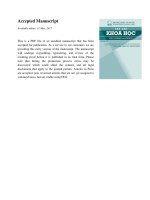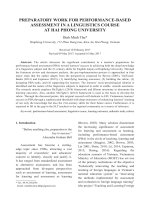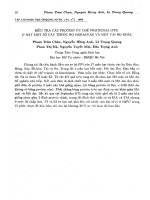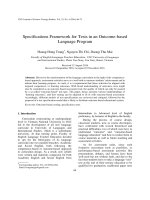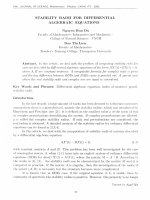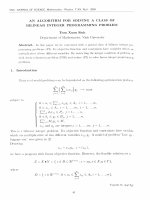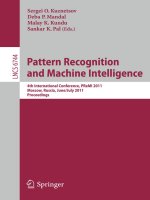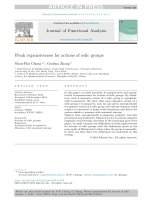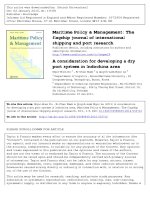DSpace at VNU: Blur estimation for barcode recognition in out-of-focus images
Bạn đang xem bản rút gọn của tài liệu. Xem và tải ngay bản đầy đủ của tài liệu tại đây (10.13 MB, 493 trang )
Lecture Notes in Computer Science
Commenced Publication in 1973
Founding and Former Series Editors:
Gerhard Goos, Juris Hartmanis, and Jan van Leeuwen
Editorial Board
David Hutchison
Lancaster University, UK
Takeo Kanade
Carnegie Mellon University, Pittsburgh, PA, USA
Josef Kittler
University of Surrey, Guildford, UK
Jon M. Kleinberg
Cornell University, Ithaca, NY, USA
Alfred Kobsa
University of California, Irvine, CA, USA
Friedemann Mattern
ETH Zurich, Switzerland
John C. Mitchell
Stanford University, CA, USA
Moni Naor
Weizmann Institute of Science, Rehovot, Israel
Oscar Nierstrasz
University of Bern, Switzerland
C. Pandu Rangan
Indian Institute of Technology, Madras, India
Bernhard Steffen
TU Dortmund University, Germany
Madhu Sudan
Microsoft Research, Cambridge, MA, USA
Demetri Terzopoulos
University of California, Los Angeles, CA, USA
Doug Tygar
University of California, Berkeley, CA, USA
Gerhard Weikum
Max Planck Institute for Informatics, Saarbruecken, Germany
6744
Sergei O. Kuznetsov Deba P. Mandal
Malay K. Kundu Sankar K. Pal (Eds.)
Pattern Recognition
and Machine Intelligence
4th International Conference, PReMI 2011
Moscow, Russia, June 27 – July 1, 2011
Proceedings
13
Volume Editors
Sergei O. Kuznetsov
National Research University Higher School of Economics
School for Applied Mathematics and Information Science
11 Pokrovski Boulevard, 109028 Moscow, Russia
E-mail:
Deba P. Mandal
Malay K. Kundu
Sankar K. Pal
Indian Statistical Institute, Machine Intelligence Unit
203, B.T. Road, Kolkata 700108, India
E-mail: {dpmandal, malay, sankar}@isical.ac.in
ISSN 0302-9743
e-ISSN 1611-3349
e-ISBN 978-3-642-21786-9
ISBN 978-3-642-21785-2
DOI 10.1007/978-3-642-21786-9
Springer Heidelberg Dordrecht London New York
Library of Congress Control Number: 2011929642
CR Subject Classification (1998): I.4, F.1, I.2, I.5, J.3, H.3-4, K.4.4, C.1.3
LNCS Sublibrary: SL 6 – Image Processing, Computer Vision, Pattern Recognition,
and Graphics
© Springer-Verlag Berlin Heidelberg 2011
This work is subject to copyright. All rights are reserved, whether the whole or part of the material is
concerned, specifically the rights of translation, reprinting, re-use of illustrations, recitation, broadcasting,
reproduction on microfilms or in any other way, and storage in data banks. Duplication of this publication
or parts thereof is permitted only under the provisions of the German Copyright Law of September 9, 1965,
in its current version, and permission for use must always be obtained from Springer. Violations are liable
to prosecution under the German Copyright Law.
The use of general descriptive names, registered names, trademarks, etc. in this publication does not imply,
even in the absence of a specific statement, that such names are exempt from the relevant protective laws
and regulations and therefore free for general use.
Typesetting: Camera-ready by author, data conversion by Scientific Publishing Services, Chennai, India
Printed on acid-free paper
Springer is part of Springer Science+Business Media (www.springer.com)
Preface
This volume contains the proceedings of the 4th International Conference on
Pattern Recognition and Machine Intelligence (PReMI-2011) which was held at
the National Research University Higher School of Economics (HSE), Moscow,
Russia, during June 27 - July 1, 2011. This was the fourth conference in the
series. The first three conferences were held in December at the Indian Statistical Institute, Kolkata, India, in 2005 and 2007 and at the Indian Institute of
Technology, New Delhi, India, in 2009.
PReMI has become a premier international conference presenting the state-ofart research findings in the areas of machine intelligence and pattern recognition.
The conference is also successful in encouraging academic and industrial interaction, and in promoting collaborative research and developmental activities in
pattern recognition, machine intelligence and other allied fields, involving scientists, engineers, professionals, researchers and students from India and abroad.
The conference is scheduled to be held every alternate year making it an ideal
platform for sharing views, new results and experiences in these fields in a regular
manner.
PReMI-2011 attracted 140 submissions from 21 different countries across the
world. Each paper was subjected to at least two reviews; the majority had three
reviews. The review process was handled by the PC members with the help of
additional reviewers. These reviews were analyzed by the PC Co-chairs. Finally,
on the basis of reviews, it was decided to accept 65 papers for oral and poster
sessions. We are grateful to the PC members and reviewers for providing critical
reviews. This volume contains the final version of these 65 papers after incorporating reviewers’ suggestions. These papers have been organized under nine
thematic sections.
For PReMI-2011, we had a distinguished panel of keynote and plenary speakers. We are grateful to Rakesh Agrawal for agreeing to deliver the keynote talk.
We are also grateful to John Oommen, Mikhail Roytberg, Boris Mirkin, Santanu Chaudhury, and Alexei Chervonenkis for delivering the plenary talks. Our
Tutorial Co-chairs arranged an excellent set of pre-conference tutorials. We are
thankful to all the tutorial speakers.
We would like to take this as an opportunity to thank the host institute,
National Research University Higher School of Economics, Moscow, for providing all facilities to organize this conference. We are grateful to the co-organizer
Laboratoire Poncelet (UMI 2615 du CNRS, Moscow). We are also grateful to
Springer, Heidelberg, for publishing the volume and the National Centre for
Soft Computing Research, ISI, Kolkata, for providing the necessary support.
The success of the conference is also due to the funding received from different
VI
Preface
agencies and industrial partners, among them ABBYY, the Russian Foundation
for Basic Research, Yandex, and Russian Association for Artificial Intelligence
(RAAI). We are thankful to all of them for their active support. We are grateful
to the Organizing Committee for their endeavor in making this conference a
success. The volume editors would like to especially thank our Organizing Chair
Dmitry Ignatov for his enormous contributions toward the organization of the
conference and publication of these proceedings. Our special thanks are also due
´ ezak for his kind co-operation, co-ordination and help, and for
to Dominik Sl
being involved in one form or other with PReMI since its first edition in 2005.
And last, but not least, we thank the members of our Advisory Committee
who provided the required guidance and sponsors. PReMI-2005, PReMI-2007
and PReMI-2009 were successful conferences. We believe that you will find the
proceedings of PReMI-2011 to be a valuable source of reference for your ongoing
and future research activities.
April 2011
Sergei O. Kuznetsov
Deba P. Mandal
Malay K. Kundu
Sankar K. Pal
Organization
General Chair
Conference Chair
Program Co-chairs
Organizing Chair
Tutorial Co-chairs
Publicity Co-chairs
Coordination Chair
Sankar K. Pal, ISI Kolkata, India
Sergei O. Kuznetsov, Higher School of
Economics, Russia
Malay K. Kundu, ISI, Kolkata, India
Deba P. Mandal, ISI, Kolkata, India
Dmitry I. Ignatov, Higher School of Economics,
Russia
Chris Cornelis, Ghent University, Belgium
Sanghamitra Bandyopadhyay, ISI, Kolkata,
India
Goutam Chakraborty, Iwate Prefectural
University, Japan
Joydeep Ghosh, University of Texas, USA
Simon C. K. Shiu, HK Polytechnical
University, Hong Kong
Advisory Committee
Lotfi Zadeh, USA
Michael Brady, UK
Anil Jain, USA
Josef Kittler, UK
Rama Chellappa, USA
Gennady S. Osipov, Russia
Witold Pedrycz, Canada
Andrzej Skowron, Poland
Brian C. Lovell, Australia
Dwijesh Dutta Majumdar, India
Arun Majumder, India
Konstantin V. Rudakov, Russia
Konstantin Anisimovich, Russia
Gabriella Sanniti di Baja, Italy
B. Yegnanarayana, India
B.L. Deekshatulu, India
Program Committee
Tinku Acharya
Aditya Bagchi
Sanghamitra Bandyopadhyay
Roberto Baragona
Andrzej Bargiela
Jayanta Basak
Tanmay Basu
Dinabandhu Bhandari
Bhargab B. Bhattacharya
Intelectual Ventures, Kolkata, India
Indian Statistical Institute, Kolkata, India
Indian Statistical Institute,Kolkata, India
Sapienza University of Rome, Rome, Italy
University of Nottingham, Selangor Darul
Ehsan, Malaysia
IBM Research, Bangalore, India
Indian Statistical Institute, Kolkata, India
Indian Statistical Institute, Kolkata, India
Indian Statistical Institute, Kolkata, India
VIII
Organization
Pushpak Bhattacharyya
Kanad Biswas
Prabir Kumar Biswas
Sambhunath Biswas
Smarajit Bose
Lorenzo Bruzzone
Roberto Cesar
Partha P. Chakrabarti
Mihir Chakraborty
Bhabatosh Chanda
Subhasis Chaudhuri
Santanu Chaudhury
Sung-Bae Cho
Sudeb Das
Sukhendu Das
B.S. Dayasagar
Rajat K. De
Kalyanmoy Deb
Lipika Dey
Sumantra Dutta Roy
Utpal Garain
Ashish Ghosh
Hiranmay Ghosh
Kuntal Ghosh
Sujata Ghosh
Susmita Ghosh
Phalguni Gupta
C.V. Jawahar
Grigori Kabatianski
Vladimir F. Khoroshevsky
Indian Institute of Technology Bombay,
Mumbai, India
Indian Institute of Technology Delhi,
New Delhi, India
Indian Institute of Technology Kharagpur,
Kharagpur, India
Indian Statistical Institute, Kolkata, India
Indian statistical Institute, Kolkata, India
University of Trento, Italy
University of S˜
ao Paulo, S˜
ao Carlos, Brazil
Indian Institute of Technology Kharagpur,
Kharagpur, India
Indian Statistical Institute, Kolkata, India
Indian Statistical Institute, Kolkata, India
Indian Institute of Technology Bombay,
Mumbai, India
Indian Institute of Technology Delhi,
New Delhi, India
Yonsei University, Seoul, Korea
Indian Statistical Institute, Kolkata, India
Indian Institute of Technology Madras,
Chennai, India
Indian Statistical Institute, Bangalore, India
Indian Statistical Institute, Kolkata, India
Indian Institute of Technology Kanpur,
Kanpur, India
Tata Consultancy Services Ltd., New Delhi,
India
Indian Institute of Technology Delhi,
New Delhi, India
Indian Statistical Institute, Kolkata, India
Indian Statistical Institute, Kolkata, India
Tata Consultancy Services Ltd., New Delhi,
India
Indian Statistical Institute, Kolkata, India
University of Groningen, Netherlands
Jadavpur University, Kolkata, India
Indian Institute of Technology Kanpur,
Kanpur, India
IIIT, Hyderabad, India
Institute for Information Transmission
Problems of Russian Academy of Sciences,
Moscow, Russia
Computing Centre of Russian Academy of
Sciences, Moscow, Russia
Organization
Ravi Kothari
Malay K. Kundu
Sergei O. Kuznetsov
Yan Li
Lucia Maddalena
Pradipta Maji
Deba P. Mandal
Anton Masalovitch
Francesco Masulli
Pabitra Mitra
Suman Mitra
Sushmita Mitra
Dipti P. Mukherjee
Jayanta Mukherjee
C.A. Murthy
Narasimha Murty Musti
Sarif Naik
Tomaharu Nakashima
B.L. Narayana
Ben Niu
Sergei Obiedkov
Nikhil R. Pal
Pinakpani Pal
Sankar K. Pal
Swapan K. Parui
Gabriella Pasi
Leif Peterson
Alfredo Petrosino
Arun K. Pujari
Ganesh Ramakrishnan
Shubhra S. Ray
Siddheswar Roy
Suman Saha
P.S. Sastry
Debashis Sen
Srinivasan Sengamedu
Rudy Setiono
B. Uma Shankar
Roberto Tagliaferri
IX
IBM Research, New Delhi, India
Indian Statistical Institute, Kolkata, India
Higher School of Economics, Moscow, Russia
The Hong Kong Polytechnic University,
Hong Kong, China
National Research Council, Naples, Italy
Indian Statistical Institute, Kolkata, India
Indian Statistical Institute, Kolkata, India
ABBYY, Moscow, Russia
Universita’ di Genova, Genova, Italy
Indian Institute of Technology Kharagpur,
Kharagpur, India
DAIICT, Gandhinagar, India
Indian Statistical Institute, Kolkata, India
Indian Statistical Institute, Kolkata, India
Indian Institute of Technology Kharagpur,
Kharagpur, India
Indian Statistical Institute, Kolkata, India
Indian Institute of Science, Bangalore, India
Philips India, Bangalore, India
University of Osaka Prefecture, Osaka, Japan
Yahoo India, Bangalore, India
The Hong Kong Polytechnic University,
Hong Kong, China
Higher School of Economics, Moscow, Russia
Indian Statistical Institute, Kolkata, India
Indian Statistical Institute, Kolkata, India
Indian Statistical Institute, Kolkata, India
Indian Statistical Institute, Kolkata, India
Universita’ di Milano Bicocca, Milano, Italy
The Methodist Hospital Research Institute,
Houston, USA
University of Naples, Italy
LNM IIT, Jaipur, India
Indian Institute of Technology Bombay,
Mumbai, India
Indian Statistical Institute, Kolkata, India
Monash University, Melbourne, Australia
Indian Statistical Institute, Kolkata, India
Indian Institute of Science, Bangalore, India
Indian Statistical Institute, Kolkata, India
Yahoo! Labs, Bangalore, India
National University of Singapore, Singapore
Indian Statistical Institute, Kolkata, India
Universita’ di Salerno, Italy
X
Organization
Tieniu Tan
Yuan Y. Tang
Dmitri V. Vinorgadov
Yury Vizliter
Konstantin V. Vorontsov
Guoyin Wang
Jason Wang
Narahari Yadati
Ning Zhong
Chinese Academy of Sciences, Beijing, China
Hong Kong Baptist University, Hongkong,
China
All-Russian Institute for Scientific and
Technical Information of Russian Academy
of Sciences, Moscow, Russia
State Research Institute of Aviation Systems,
Moscow, Russia
Computing Centre of Russian Academy of
Sciences, Moscow, Russia
Chongqing University of Posts and
Telecommunications, China
New Jersey Institute of Technology, USA
Indian Institute of Science, Bangalore, India
Maebashi Institute of Technology, Japan
Additional Reviewers
Bhadra, Tapas
Dhara, Bibhas
Gupta, Lalit
Halder, Anindya
Jayaraman, Umarani
Khan, Aquil
Kumar, Rajesh
M., Arunkumar
Makkapati, Vishnu
Marrara, Stefania
Nigam, Aditya
Prakash, Surya
Saha, Sanjoy Kumar
Samanta, Syamal
Sen, Jayanta
Sengupta, Debarka
Vajinepalli, Pallavi
Message from the General Chair
Machine intelligence conveys a core concept for integrating various advanced
technologies with the basic task of pattern recognition and learning. Intelligent
autonomous systems (IAS) is the physical embodiment of machine intelligence.
The basic philosophy of IAS research is to explore and understand the nature
of intelligence involved in problems of perception, reasoning, learning, optimization and control in order to develop and implement the theory into engineered
realization. Advanced technologies concerning machine intelligence research include fuzzy logic, artificial neural networks, evolutionary computation, rough
sets, their different hybridizations, approximate reasoning, probabilistic reasoning and case-based reasoning. These technologies are required for the designing
of IAS. While the role of these individual tools is apparent in designing pattern recognition and intelligent systems, making judicious integration of these
tools has drawn considerable attention from researchers for more than a decade
under the term soft computing, whose aim is to exploit the tolerance for imprecision, uncertainty, approximate reasoning and partial truth to achieve tractability,
robustness, low-cost solutions, and close resemblance with human-like decision
making.
One may note that there are several conferences being held over the globe
on pattern recognition and machine intelligence separately, but hardly any that
combines them, although both communities share many of the concepts and
tasks under different names. Based on this realization, The first International
Conference on Pattern Recognition and Machine Intelligence, called PReMI-05,
was initiated by the Machine Intelligence Unit (MIU) of the Indian Statistical
Institute (ISI) at its headquarters in Kolkata in December 2005. One of the objectives is to provide a common platform to both communities to share thoughts
for the advancement of the subjects. This conference is a biannual event. The
next version PReMI-2007 was also held at ISI, Kolkata, in December 2007.
During PReMI-2005 and PReMI-2007, we received several requests to let this
conference be held outside ISI, Kolkata, and even abroad to increase its visibility
and provide more benefits to researchers elsewhere. Accordingly, PReMI-2009
was held at IIT-Delhi, India, in December 2009. I am extremely happy to mention
that Sergei Kuznetsov volunteered to organize the fourth event (PReMI-2011)
in the series at the National Research University Higher School of Economics,
Moscow, Russia, during June 26–30, 2011 in collaboration with the Machine
Intelligence Unit, ISI, Kolkata.
Like the previous edition, PReMI-2011 was planned to be held in conjunction with RSFDGrC-2011, an international event on rough sets, fuzzy sets and
granular computing. RSFDGrC deals mainly with the development of theoretical and applied aspects of the concerned topics. On the other hand, PReMI
has a wider scope and focuses broadly on the development and application of
XII
Message from the General Chair
those topics along with other classic and modern computing paradigms, including
pattern recognition, machine learning, mining and related disciplines with various real-life problems as in bioinformatics, Web mining, biometrics, document
processing, data security, video information retrieval, social network mining and
remote sensing, among others. All these make the joint event an ideal platform to
both theoretical and applied researchers as well as practitioners for collaborative
research.
I take this opportunity to thank the National Research University, Higher
´ ezak for his
School of Economics, Moscow, for holding the meeting, Dominik Sl
initiative and co-ordination, and the members of the Organizing, Program and
other Committees for their sincere effort in making it a reality. Thanks are also
due to all the financial and academic sponsors for their support of this endeavor,
and Springer for publishing the PReMI proceedings in their prestigious LNCS
series.
Sankar K. Pal
Table of Contents
Invited Talks
Enriching Education through Data Mining . . . . . . . . . . . . . . . . . . . . . . . . . .
Rakesh Agrawal, Sreenivas Gollapudi, Anitha Kannan, and
Krishnaram Kenthapadi
1
How to Visualize a Crisp or Fuzzy Topic Set over a Taxonomy . . . . . . . . .
Boris Mirkin, Susana Nascimento, Trevor Fenner, and Rui Felizardo
3
On Merging the Fields of Neural Networks and Adaptive Data
Structures to Yield New Pattern Recognition Methodologies . . . . . . . . . . .
B. John Oommen
13
Quality of Algorithms for Sequence Comparison . . . . . . . . . . . . . . . . . . . . . .
Mikhail Roytberg
17
Problems of Machine Learning . . . . . . . . . . . . . . . . . . . . . . . . . . . . . . . . . . . . .
Alexei Ya. Chervonenkis
21
Pattern Recognition and Machine Learning
Bayesian Approach to the Pattern Recognition Problem in
Nonstationary Environment . . . . . . . . . . . . . . . . . . . . . . . . . . . . . . . . . . . . . . .
Olga V. Krasotkina, Vadim V. Mottl, and Pavel A. Turkov
The Classification of Noisy Sequences Generated by Similar HMMs . . . . .
Alexander A. Popov and Tatyana A. Gultyaeva
24
30
N DoT : Nearest Neighbor Distance Based Outlier Detection
Technique . . . . . . . . . . . . . . . . . . . . . . . . . . . . . . . . . . . . . . . . . . . . . . . . . . . . . . .
Neminath Hubballi, Bidyut Kr. Patra, and Sukumar Nandi
36
Some Remarks on the Relation between Annotated Ordered Sets and
Pattern Structures . . . . . . . . . . . . . . . . . . . . . . . . . . . . . . . . . . . . . . . . . . . . . . .
Tim B. Kaiser and Stefan E. Schmidt
43
Solving the Structure-Property Problem Using k-NN Classification . . . . .
Aleksandr Perevoznikov, Alexey Shestov, Evgenii Permiakov, and
Mikhail Kumskov
Stable Feature Extraction with the Help of Stochastic Information
Measure . . . . . . . . . . . . . . . . . . . . . . . . . . . . . . . . . . . . . . . . . . . . . . . . . . . . . . . .
Alexander Lepskiy
49
54
XIV
Table of Contents
Wavelet-Based Clustering of Social-Network Users Using Temporal and
Activity Profiles . . . . . . . . . . . . . . . . . . . . . . . . . . . . . . . . . . . . . . . . . . . . . . . . .
Lipika Dey and Bhakti Gaonkar
60
Tight Combinatorial Generalization Bounds for Threshold Conjunction
Rules . . . . . . . . . . . . . . . . . . . . . . . . . . . . . . . . . . . . . . . . . . . . . . . . . . . . . . . . . . .
Konstantin Vorontsov and Andrey Ivahnenko
66
An Improvement of Dissimilarity-Based Classifications Using SIFT
Algorithm . . . . . . . . . . . . . . . . . . . . . . . . . . . . . . . . . . . . . . . . . . . . . . . . . . . . . . .
Evensen E. Masaki and Sang-Woon Kim
74
Introduction, Elimination Rules for ¬ and ⊃: A Study from Graded
Context . . . . . . . . . . . . . . . . . . . . . . . . . . . . . . . . . . . . . . . . . . . . . . . . . . . . . . . . .
Soma Dutta
80
Image Analysis
Discrete Circular Mapping for Computation of Zernike Moments . . . . . . .
Rajarshi Biswas and Sambhunath Biswas
86
Unsupervised Image Segmentation with Adaptive Archive-Based
Evolutionary Multiobjective Clustering . . . . . . . . . . . . . . . . . . . . . . . . . . . . .
Chin Wei Bong and Hong Yoong Lam
92
Modified Self-Organizing Feature Map Neural Network with
Semi-supervision for Change Detection in Remotely Sensed Images . . . . .
Susmita Ghosh and Moumita Roy
98
Image Retargeting through Constrained Growth of Important
Rectangular Partitions . . . . . . . . . . . . . . . . . . . . . . . . . . . . . . . . . . . . . . . . . . . .
Rajarshi Pal, Jayanta Mukhopadhyay, and Pabitra Mitra
104
SATCLUS: An Effective Clustering Technique for Remotely Sensed
Images . . . . . . . . . . . . . . . . . . . . . . . . . . . . . . . . . . . . . . . . . . . . . . . . . . . . . . . . .
Sauravjyoti Sarmah and Dhruba K. Bhattacharyya
110
Blur Estimation for Barcode Recognition in Out-of-Focus Images . . . . . .
Duy Khuong Nguyen, The Duy Bui, and Thanh Ha Le
Entropy-Based Automatic Segmentation of Bones in Digital X-ray
Images . . . . . . . . . . . . . . . . . . . . . . . . . . . . . . . . . . . . . . . . . . . . . . . . . . . . . . . . .
Oishila Bandyopadhyay, Bhabatosh Chanda, and
Bhargab B. Bhattacharya
Principle and Method of Image Recognition under Diffusive Distortions
of Image . . . . . . . . . . . . . . . . . . . . . . . . . . . . . . . . . . . . . . . . . . . . . . . . . . . . . . . .
Jaser Doroshenko, Lev Dulkin, Viktor Salakhutdinov, and
Yury Smetanin
116
122
130
Table of Contents
Regression Models for Texture Image Analysis . . . . . . . . . . . . . . . . . . . . . . .
Anatoliy Plastinin
XV
136
Shape Descriptor Based on the Volume of Transformed Image
Boundary . . . . . . . . . . . . . . . . . . . . . . . . . . . . . . . . . . . . . . . . . . . . . . . . . . . . . . .
Xavier Descombes and Sergey Komech
142
Color Image Segmentation Using a Semi-wrapped Gaussian Mixture
Model . . . . . . . . . . . . . . . . . . . . . . . . . . . . . . . . . . . . . . . . . . . . . . . . . . . . . . . . . .
Anandarup Roy, Swapan K. Parui, Debyani Nandi, and Utpal Roy
148
Perception-Based Design for Tele-presence . . . . . . . . . . . . . . . . . . . . . . . . . .
Santanu Chaudhury, Shantanu Ghosh, Amrita Basu,
Brejesh Lall, Sumantra Dutta Roy, Lopamudra Choudhury,
R. Prashanth, Ashish Singh, and Amit Maniyar
Automatic Adductors Angle Measurement for Neurological Assessment
of Post-neonatal Infants during Follow Up . . . . . . . . . . . . . . . . . . . . . . . . . . .
Debi Prosad Dogra, Arun Kumar Majumdar, Shamik Sural,
Jayanta Mukherjee, Suchandra Mukherjee, and Arun Singh
154
160
Image and Video Information Retrieval
Interactive Image Retrieval with Wavelet Features . . . . . . . . . . . . . . . . . . . .
Malay Kumar Kundu, Manish Chowdhury, and Minakshi Banerjee
Moving Objects Detection from Video Sequences Using Fuzzy Edge
Incorporated Markov Random Field Modeling and Local Histogram
Matching . . . . . . . . . . . . . . . . . . . . . . . . . . . . . . . . . . . . . . . . . . . . . . . . . . . . . . .
Badri Narayan Subudhi and Ashish Ghosh
Combined Topological and Directional Relations Based Motion Event
Predictions . . . . . . . . . . . . . . . . . . . . . . . . . . . . . . . . . . . . . . . . . . . . . . . . . . . . . .
Nadeem Salamat and El-hadi Zahzah
Recognizing Hand Gestures of a Dancer . . . . . . . . . . . . . . . . . . . . . . . . . . . . .
Divya Hariharan, Tinku Acharya, and Sushmita Mitra
Spatiotemporal Approach for Tracking Using Rough Entropy and
Frame Subtraction . . . . . . . . . . . . . . . . . . . . . . . . . . . . . . . . . . . . . . . . . . . . . . .
B. Uma Shankar and Debarati Chakraborty
OSiMa : Human Pose Estimation from a Single Image . . . . . . . . . . . . . . . .
Nipun Pande and Prithwijit Guha
Scene Categorization Using Topic Model Based Hierarchical Conditional
Random Fields . . . . . . . . . . . . . . . . . . . . . . . . . . . . . . . . . . . . . . . . . . . . . . . . . .
Vikram Garg, Ehtesham Hassan, Santanu Chaudhury, and
Madan Gopal
167
173
180
186
193
200
206
XVI
Table of Contents
Uncalibrated Camera Based Interactive 3DTV . . . . . . . . . . . . . . . . . . . . . . .
M.S. Venkatesh, Santanu Chaudhury, and Brejesh Lall
213
Natural Language Processing and Text and Data
Mining
Author Identification in Bengali Literary Works . . . . . . . . . . . . . . . . . . . . . .
Suprabhat Das and Pabitra Mitra
220
Finding Potential Seeds through Rank Aggregation of Web Searches . . . .
¨ urk
Rajendra Prasath and Pinar Ozt¨
227
Combining Evidence for Automatic Extraction of Terms . . . . . . . . . . . . . .
Boris Dobrov and Natalia Loukachevitch
235
A New Centrality Measure for Influence Maximization in Social
Networks . . . . . . . . . . . . . . . . . . . . . . . . . . . . . . . . . . . . . . . . . . . . . . . . . . . . . . .
Suman Kundu, C.A. Murthy, and Sankar K. Pal
Method of Cognitive Semantic Analysis of Russian Sentence . . . . . . . . . . .
Alexander Bolkhovityanov and Andrey Chepovskiy
Data Representation in Machine Learning-Based Sentiment Analysis of
Customer Reviews . . . . . . . . . . . . . . . . . . . . . . . . . . . . . . . . . . . . . . . . . . . . . . .
Ivan Shamshurin
Automatic Retrieval of Parallel Collocations . . . . . . . . . . . . . . . . . . . . . . . . .
Valeriy I. Novitskiy
Displacement Based Unsupervised Metric for Evaluating Rank
Aggregation . . . . . . . . . . . . . . . . . . . . . . . . . . . . . . . . . . . . . . . . . . . . . . . . . . . . .
Maunendra Sankar Desarkar, Rahul Joshi, and Sudeshna Sarkar
Sentence Ranking for Document Indexing . . . . . . . . . . . . . . . . . . . . . . . . . . .
Saptaditya Maiti, Deba P. Mandal, and Pabitra Mitra
242
248
254
261
268
274
Watermarking, Steganography and Biometrics
Optimal Parameter Selection for Image Watermarking Using MOGA . . .
Dinabandhu Bhandari, Lopamudra Kundu, and Sankar K. Pal
Hybrid Contourlet-DCT Based Robust Image Watermarking Technique
Applied to Medical Data Management . . . . . . . . . . . . . . . . . . . . . . . . . . . . . .
Sudeb Das and Malay Kumar Kundu
Accurate Localizations of Reference Points in a Fingerprint Image . . . . . .
Malay Kumar Kundu and Arpan Kumar Maiti
280
286
293
Table of Contents
XVII
Adaptive Pixel Swapping Based Steganography Reducing Embedding
Noise . . . . . . . . . . . . . . . . . . . . . . . . . . . . . . . . . . . . . . . . . . . . . . . . . . . . . . . . . . .
Arijit Sur, Piyush Goel, and Jayanta Mukhopadhyay
299
Classification and Quantification of Occlusion Using Hidden Markov
Model . . . . . . . . . . . . . . . . . . . . . . . . . . . . . . . . . . . . . . . . . . . . . . . . . . . . . . . . . .
Chitta Ranjan Sahoo, Shamik Sural, Gerhard Rigoll, and A. Sanchez
305
Soft Computing and Applications
IC-Topological Spaces and Applications in Soft Computing . . . . . . . . . . . .
Subrata Bhowmik
311
Neuro-Genetic Approach for Detecting Changes in Multitemporal
Remotely Sensed Images . . . . . . . . . . . . . . . . . . . . . . . . . . . . . . . . . . . . . . . . . .
Aditi Mandal, Susmita Ghosh, and Ashish Ghosh
318
Synthesis and Characterization of Gold Nanoparticles – A Fuzzy
Mathematical Approach . . . . . . . . . . . . . . . . . . . . . . . . . . . . . . . . . . . . . . . . . .
D. Dutta Majumder, Sankar Karan, and A. Goswami
324
A Rough Set Based Decision Tree Algorithm and Its Application in
Intrusion Detection . . . . . . . . . . . . . . . . . . . . . . . . . . . . . . . . . . . . . . . . . . . . . . .
Lin Zhou and Feng Jiang
333
Information Systems and Rough Set Approximations: An Algebraic
Approach . . . . . . . . . . . . . . . . . . . . . . . . . . . . . . . . . . . . . . . . . . . . . . . . . . . . . . .
Md. Aquil Khan and Mohua Banerjee
339
Clustering and Network Analysis
Approximation of a Coal Mass by an Ultrasonic Sensor Using
Regression Rules . . . . . . . . . . . . . . . . . . . . . . . . . . . . . . . . . . . . . . . . . . . . . . . . .
Marek Sikora, Marcin Michalak, and Beata Sikora
Forecasting the U.S. Stock Market via Levenberg-Marquardt and
Haken Artificial Neural Networks Using ICA and PCA Pre-processing
Techniques . . . . . . . . . . . . . . . . . . . . . . . . . . . . . . . . . . . . . . . . . . . . . . . . . . . . . .
Sergey Golovachev
345
351
Empirical Study of Matrix Factorization Methods for Collaborative
Filtering . . . . . . . . . . . . . . . . . . . . . . . . . . . . . . . . . . . . . . . . . . . . . . . . . . . . . . . .
Evgeny Kharitonov
358
Simultaneous Non-gaussian Data Clustering, Feature Selection and
Outliers Rejection . . . . . . . . . . . . . . . . . . . . . . . . . . . . . . . . . . . . . . . . . . . . . . . .
Nizar Bouguila, Djemel Ziou, and Sabri Boutemedjet
364
XVIII
Table of Contents
Simultaneous Clustering: A Survey . . . . . . . . . . . . . . . . . . . . . . . . . . . . . . . . .
Malika Charrad and Mohamed Ben Ahmed
370
Analysis of Centrality Measures of Airport Network of India . . . . . . . . . . .
Manasi Sapre and Nita Parekh
376
Clusters of Multivariate Stationary Time Series by Differential
Evolution and Autoregressive Distance . . . . . . . . . . . . . . . . . . . . . . . . . . . . . .
Roberto Baragona
382
Bio and Chemo Informatics
Neuro-fuzzy Methodology for Selecting Genes Mediating Lung
Cancer . . . . . . . . . . . . . . . . . . . . . . . . . . . . . . . . . . . . . . . . . . . . . . . . . . . . . . . . .
Rajat K. De and Anupam Ghosh
388
A Methodology for Handling a New Kind of Outliers Present in Gene
Expression Patterns . . . . . . . . . . . . . . . . . . . . . . . . . . . . . . . . . . . . . . . . . . . . . .
Anindya Bhattacharya and Rajat K. De
394
Developmental Trend Derived from Modules of Wnt Signaling
Pathways . . . . . . . . . . . . . . . . . . . . . . . . . . . . . . . . . . . . . . . . . . . . . . . . . . . . . . .
Losiana Nayak and Rajat K. De
400
Evaluation of Semantic Term and Gene Similarity Measures . . . . . . . . . . .
Michal Kozielski and Aleksandra Gruca
Finding Bicliques in Digraphs: Application into Viral-Host Protein
Interactome . . . . . . . . . . . . . . . . . . . . . . . . . . . . . . . . . . . . . . . . . . . . . . . . . . . . .
Malay Bhattacharyya, Sanghamitra Bandyopadhyay, and
Ujjwal Maulik
406
412
Document Image Processing
Advantages of the Extended Water Flow Algorithm for Handwritten
Text Segmentation . . . . . . . . . . . . . . . . . . . . . . . . . . . . . . . . . . . . . . . . . . . . . . .
Darko Brodi´c
418
Construction of Model of Structured Documents Based on Machine
Learning . . . . . . . . . . . . . . . . . . . . . . . . . . . . . . . . . . . . . . . . . . . . . . . . . . . . . . . .
Sergey Golubev
424
Segmental K-Means Learning with Mixture Distribution for HMM
Based Handwriting Recognition . . . . . . . . . . . . . . . . . . . . . . . . . . . . . . . . . . . .
Tapan Kumar Bhowmik, Jean-Paul van Oosten, and
Lambert Schomaker
432
Table of Contents
Feature Set Selection for On-line Signatures Using Selection of
Regression Variables . . . . . . . . . . . . . . . . . . . . . . . . . . . . . . . . . . . . . . . . . . . . . .
Desislava Boyadzieva and Georgi Gluhchev
XIX
440
Headline Based Text Extraction from Outdoor Images . . . . . . . . . . . . . . . .
Ranjit Ghoshal, Anandarup Roy, Tapan Kumar Bhowmik, and
Swapan K. Parui
446
Incremental Methods in Collaborative Filtering for Ordinal Data . . . . . . .
Elena Polezhaeva
452
A Scheme for Attentional Video Compression . . . . . . . . . . . . . . . . . . . . . . . .
Rupesh Gupta and Santanu Chaudhury
458
Using Conceptual Graphs for Text Mining in Technical Support
Services . . . . . . . . . . . . . . . . . . . . . . . . . . . . . . . . . . . . . . . . . . . . . . . . . . . . . . . . .
Michael Bogatyrev and Alexey Kolosoff
466
Erratum
Evaluation of Semantic Term and Gene Similarity Measures . . . . . . . . . . .
Michal Kozielski and Aleksandra Gruca
E1
Author Index . . . . . . . . . . . . . . . . . . . . . . . . . . . . . . . . . . . . . . . . . . . . . . . . . .
473
Enriching Education through Data Mining
Rakesh Agrawal, Sreenivas Gollapudi,
Anitha Kannan, and Krishnaram Kenthapadi
Search Labs, Microsoft Research
Mountain View, CA, USA
{rakesha,sreenig,ankannan,krisken}@microsoft.com
Education is acknowledged to be the primary vehicle for improving the economic
well-being of people [1,6]. Textbooks have a direct bearing on the quality of education imparted to the students as they are the primary conduits for delivering
content knowledge [9]. They are also indispensable for fostering teacher learning
and constitute a key component of the ongoing professional development of the
teachers [5,8].
Many textbooks, particularly from emerging countries, lack clear and adequate coverage of important concepts [7]. In this talk, we present our early
explorations into developing a data mining based approach for enhancing the
quality of textbooks. We discuss techniques for algorithmically augmenting different sections of a book with links to selective content mined from the Web.
For finding authoritative articles, we first identify the set of key concept phrases
contained in a section. Using these phrases, we find web (Wikipedia) articles
that represent the central concepts presented in the section and augment the
section with links to them [4]. We also describe a framework for finding images
that are most relevant to a section of the textbook, while respecting global relevancy to the entire chapter to which the section belongs. We pose this problem
of matching images to sections in a textbook chapter as an optimization problem
and present an efficient algorithm for solving it [2].
We also present a diagnostic tool for identifying those sections of a book that
are not well-written and hence should be candidates for enrichment. We propose a probabilistic decision model for this purpose, which is based on syntactic
complexity of the writing and the newly introduced notion of the dispersion of
key concepts mentioned in the section. The model is learned using a tune set
which is automatically generated in a novel way. This procedure maps sampled
text book sections to the closest versions of Wikipedia articles having similar
content and uses the maturity of those versions to assign need-for-enrichment
labels. The maturity of a version is computed by considering the revision history
of the corresponding Wikipedia article and convolving the changes in size with
a smoothing filter [3].
We also provide the results of applying the proposed techniques to a corpus of widely-used, high school textbooks published by the National Council of
S.O. Kuznetsov et al. (Eds.): PReMI 2011, LNCS 6744, pp. 1–2, 2011.
c Springer-Verlag Berlin Heidelberg 2011
2
R. Agrawal et al.
Educational Research and Training (NCERT), India. We consider books from
grades IX–XII, covering four broad subject areas, namely, Sciences, Social Sciences, Commerce, and Mathematics. The preliminary results are encouraging
and indicate that developing technological approaches to enhancing the quality
of textbooks could be a promising direction for research for our field.
References
1. Knowledge for Development: World Development Report 1998/99. World Bank
(1998)
2. Agrawal, R., Gollapudi, S., Kannan, A., Kenthapadi, K.: Enriching textbooks with
web images (working paper, 2011)
3. Agrawal, R., Gollapudi, S., Kannan, A., Kenthapadi, K.: Identifying enrichment
candidates in textbooks. In: WWW (2011)
4. Agrawal, R., Gollapudi, S., Kenthapadi, K., Srivastava, N., Velu, R.: Enriching
textbooks through data mining. In: First Annual ACM Symposium on Computing
for Development, ACM DEV (2010)
5. Gillies, J., Quijada, J.: Opportunity to learn: A high impact strategy for improving educational outcomes in developing countries. In: USAID Educational Quality
Improvement Program (EQUIP2) (2008)
6. Hanushek, E.A., Woessmann, L.: The role of education quality for economic growth.
Policy Research Department Working Paper 4122, World Bank (2007)
7. Mohammad, R., Kumari, R.: Effective use of textbooks: A neglected aspect of education in Pakistan. Journal of Education for International Development 3(1) (2007)
8. Oakes, J., Saunders, M.: Education’s most basic tools: Access to textbooks and instructional materials in California’s public schools. Teachers College Record 106(10)
(2004)
9. Stein, M., Stuen, C., Carnine, D., Long, R.M.: Textbook evaluation and adoption.
Reading & Writing Quarterly 17(1) (2001)
How to Visualize a Crisp or Fuzzy Topic Set
over a Taxonomy
Boris Mirkin1,2 , Susana Nascimento3 , Trevor Fenner2 , and Rui Felizardo3
1
3
Division of Applied Mathematics and Informatics, National Research University Higher School of Economics, Moscow, Russian Federation
2
Department of Computer Science, Birkbeck University of London
London WC1E 7HX, UK
Department of Computer Science and Centre for Artificial Intelligence (CENTRIA)
Faculdade de Ciˆencias e Tecnologia, Universidade Nova de Lisboa
2829-516 Caparica, Portugal
Abstract. A novel method for visualization of a fuzzy or crisp topic
set is developed. The method maps the set’s topics to higher ranks of
the taxonomy tree of the field. The method involves a penalty function
summing penalties for the chosen “head subjects” together with penalties for emerging “gaps” and “offshoots”. The method finds a mapping
minimizing the penalty function in recursive steps involving two different scenarios, that of ‘gaining a head subject’ and that of ‘not gaining
a head subject’. We illustrate the method by applying it to illustrative
and real-world data.
1
Background and Motivation
The concept of ontology as a computationally feasible environment for knowledge representation and maintenance has sprung out rather recently. The term
refers, first of all, to a set of concepts and relations between them. These pertain to the knowledge of the domain under consideration. At the inception, the
relations typically have been meant to be rule-based and fact-based. However,
with the concept of “ontology” expanding into real-world applied domains such
as in biomedicine, it would be fair to say that the core knowledge in ontology
currently is represented by a taxonomic relation that usually can be interpreted
as ”is part of”. Such are the taxonomy of living organisms in biology, ACM
Classification of Computing Subjects (ACM-CCS) [1], and more recently a set
of taxonomies comprising the SNOMED CT, the ’Systematized Nomenclature of
Medicine Clinical Terms’ [15]. Most research efforts on computationally handling
ontologies may be considered as falling in one of the three areas: (a) developing
platforms and languages for ontology representation such as OWL language (e.g.
[14]), (b) integrating ontologies (e.g. [17,7,4,8]) and (c) using them for various
purposes. Most efforts in (c) are devoted to building rules for ontological reasoning and querying utilizing the inheritance relation supplied by the ontologys
S.O. Kuznetsov et al. (Eds.): PReMI 2011, LNCS 6744, pp. 3–12, 2011.
c Springer-Verlag Berlin Heidelberg 2011
4
B. Mirkin et al.
taxonomy in the presence of different data models (e.g. [5,3,16]). These do not
attempt at approximate representations but just utilize additional possibilities
supplied by the ontology relations. Another type of ontology usage is in using
its taxonomy nodes for interpretation of data mining results such as association
rules [10,9] and clusters [6]. Our approach naturally falls within this category.
We assume a domain taxonomy has been built. What we want to do is to use the
taxonomy for representation and visualization of a query set comprised of a set
of topics corresponding to leaves of the taxonomy by related nodes of the taxonomy’s higher ranks. The representation should approximate a query topic set
in a ”natuaral” way, at a cost of some “small” discrepancies between the query
set and the taxonomy structure. This sets our work apart from other work on
queries to ontologies that rely on purely logical approaches [5,3,16].
Computational treatises such as [11] mainly rely on the definition of visualization presented in the Merriam-Webster dictionary regarding the transitive
verb “visualize” as follows: “to make visible, to see or form a mental image of”
(see Here we assume a
somewhat more restrictive view that computational visualization necessarily involves the presence of a ground image the structure of which should be well
known to the viewer. This can be a Cartesian plane, a geography map, or a
genealogy tree, or a scheme of London’s Tube . Then visualization of a data set
is such a mapping of the data on the ground image that translates important
features of the data into visible relations over the ground image. Say, objects
can be presented by points on a Cartesian plane so that the more similar are the
objects the nearer to each other the corresponding points. Or geographic objects
can be highlighted by a bright colour on a map.
Such is the visualization for a company delivering electricity to homes in a
town zone. Figure 1, taken from [2], represents the energy network over a map
of the corresponding district on which the topography and the network data
are integrated in such a way that gives the company “an unprecedented ability
to control the flow of energy by following all the maintenance and repair issues
on-line in a real time framework.
There are three major ingredients that allow for a successful representation
of the energy network:
(1) map of the district (the ground image),
(2) the energy network units (entities to be visualized), and
(3) mapping (2) at (1).
The mapping here needs not be overly complicated because the units are
located at the very same ground image in real. Moreover, one could imagine
an extension of this mapping to other infrastructure items, such as the water
supply, sewage type, and transports, so that the map could be used for more
long-term city planning tasks such as development of leisure or residential areas
and the like.
How to Visualize a Crisp or Fuzzy Topic Set over a Taxonomy
5
Fig. 1. Energy network of Con Edison Company on Manhattan New-York USA visualized by Advanced Visual Systems [2]
Is a similar mapping possible for a long-term analysis of an organization whose
activity is much less tangible? For a research department, the following analogues
to the elements of the mapping in Fig. 1 can be considered:
(1’) a tree of the ACM-CCS taxonomy of Computer Science, the ground image,
(2’) the set of CS research subjects being developed by members of the department, and
(3’) representation of the research on the taxonomy tree.
Potentially, this can be used for:
- Positioning of the organization within the ACM-CCS taxonomy;
- Analyzing and planning the structure of research being done in the organization,
- Finding nodes of excellence, nodes of failure and nodes needing improvement
for the organization;
- Discovering research elements that poorly match the structure of AMS-CCS
taxonomy;
- Planning of research and investment
- Integrating data of different organizations in a region, or on the national
level, for the purposes of regional planning and management.
2
2.1
Lifting Model and Method
Statement of the Problem
We assume that there are a number of concepts in an area of research or practice
that are structured according to the relation ”a is part of b” into a taxonomy,
6
B. Mirkin et al.
that is a rooted hierarchy T . We denote the set of its leaves by I. Each interior
node t ∈ T corresponds to a concept that generalizes the concepts corresponding
to the subset of leaves I(t) descending from t, viz. the leaves of the subtree T (t)
rooted at t, which will be referred to as the leaf-cluster of t.
A fuzzy set on I is a mapping u of I to the non-negative real numbers assigning
a membership value u(i) ≥ 0 to each i ∈ I. We refer to the set Su ⊂ I, where
Su = {i : u(i) > 0}, as the support of u.
Given a taxonomy T and a fuzzy set u on I, one can think that u is a, possibly
noisy, projection of a high rank concept to the leaves I. Under this assumption,
there should exist a “head subject” h among the interior nodes of the tree T
that more or less comprehensively (up to small errors) covers Su . Two types of
possible errors are gaps and offshoots as illustrated in Figure 2.
Topic in subject cluster
Head subject
Gap
Offshoot
Fig. 2. Three types of features in lifting a topic set within taxonomy
A gap is a maximal node g in the subtree T (h) rooted at h such thatI(g) is
disjoint from Su . The maximality of g means that I(parent(g)), the leaf-cluster
of g’s parent, does overlap Su . A gap under the head subject h can be interpreted
as a loss of the concept h by the topic set u. In contrast, establishing a node h
as a head concept can be technically referred to as a gain.
/ I(h),
An offshoot is a leaf i ∈ Su which is not covered by h, i.e., i ∈
Since no taxonomy perfectly reflects all of the real-world phenomena, some
topic sets u may refer to general concepts that are not captured in T . In this
case, two or more, rather than just one, head subjects are needed to cover them.
This motivates the following definition.
The pair (T, u) will be referred to as an interpretation query. Consider a set H
of nodes of T that covers the support Su ; that is, each i ∈ Su either belongs to H
or is a descendant of a node in H, viz. Su ⊆ ∪h∈H I(h). This set H is a possible
result of the query (T, u). Nodes in H will be referred to as head subjects if they
are interior nodes of T or offshoots if they are leaves. A node g ∈ T is a gap for
H if it is a gap for some h ∈ H. Of all the possible results H, those bearing the
minimum penalty are of interest only. A minimum penalty result sometimes is
referred to as a parsimonious one.
